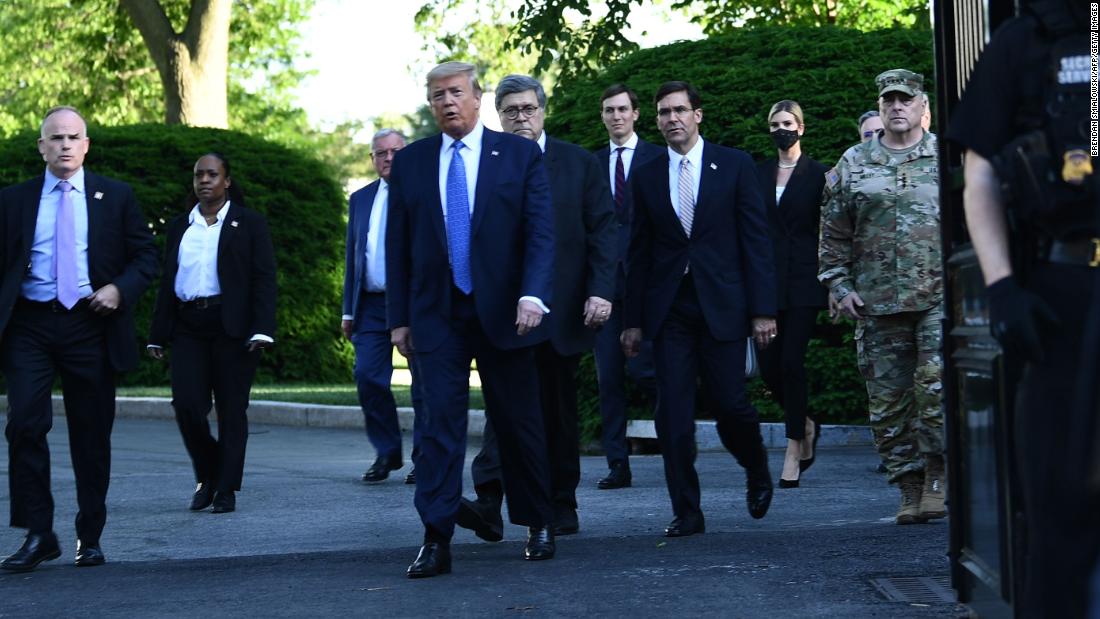
The Park Police had the authority to clear protesters during last summer’s clash outside the White House, according to the report released by the Interior Department’s inspector general on Wednesday.
Last summer, federal law enforcement agents, including Park Police, clashed with protesters near Lafayette Square, a park across the street from the White House traditionally used for peaceful protests and demonstrations.
The protesters were forcefully cleared just prior to Trump’s controversial photo at a nearby church, where he held up a Bible after he had declared himself the “law and order” President.
But, according to the watchdog’s report, “The evidence we obtained did not support a finding that the USPP cleared the park to allow the President to survey the damage and walk to St. John’s Church.”
While the report says the Park Police followed appropriate policies, it does point out ways the situation was exacerbated. For example, the Bureau of Prisons arrived late to the scene, which meant they missed a briefing in which police were told not to use pepper ball munitions unless protesters breached the bike racks surrounding the area. It’s not clear if they understood the rules of engagement, and video evidence showed a Bureau of Prisons officer firing pepper balls from inside the park, despite protesters remaining outside the bike rack perimeter.
Further, the report found that Park Police had issued three dispersal warnings prior to clearing the area, but it was clear the message wasn’t audible for everyone in the crowd.
The report also states that while they found “no evidence that the USPP and the law enforcement entities operating under the unified command deployed CS gas” to clear the park and H Street on June 1, the inspector general’s office “determined, and the MPD confirmed, that the MPD used CS gas on 17th Street on June 1.” The report notes that DC’s Metropolitan Police Department was not part of the Park Police and Secret Service’s unified command structure. The report further details the Park Police’s use of “less-lethal munitions,” including “pepper ball rounds, stinger ball grenades without irritant, and white smoke without irritant after protesters physically attacked officers.”
The inspector general’s report specifically reviewed actions taken by the Park Police, which falls under Interior’s jurisdiction through the National Park Service. The inspector general’s investigation was conducted at the request of then-Interior Secretary David Bernhardt and lawmakers.
As part of the review into Park Police operations, the watchdog “did not seek to interview Attorney General William Barr, White House personnel, Federal Bureau of Prisons (BOP) officers, MPD personnel, or Secret Service personnel regarding their independent decisions that did not involve the USPP.” The inspector general’s office also notes that, as part of its review, it did not evaluate “individual uses of force by USPP officers,” which are “the subject of separate inquiries or ongoing lawsuits.”
The report documents show that on May 30, the Park Police and Secret Service, after assessing recent acts of violence that had occurred amid the ongoing protests, decided “to establish a more secure perimeter around Lafayette Park and discussed procuring an antiscale fence.”
On the morning of June 1, the Park Police and Secret Service began developing a plan for a contractor to install fencing, which would require the park to be cleared. At noon that day, the Secret Service said the fencing contractor could proceed, and the contractor’s employees arrived later that afternoon to install the fencing.
According to the report, the Park Police incident commander said he would’ve secured the perimeter earlier had there been enough officers in place (the report says many officers weren’t reporting for duty until later that afternoon due to late hours the previous days).
It wasn’t until mid- to late afternoon that day that the Park Police learned of the possibility of Trump’s potential movement to the park, the report said, and they were not given a specific time.
According to the report, “the evidence we reviewed showed that the USPP cleared the park to allow the contractor to safely install the antiscale fencing in response to destruction of property and injury to officers occurring on May 30 and 31. Further, the evidence showed that the USPP did not know about the President’s potential movement until mid-to late afternoon on June 1 — hours after it had begun developing its operational plan and the fencing contractor had arrived in the park.”
The head of the Park Police similarly had told Congress last year that Trump’s visit to the church was not the motivation for clearing the area of peaceful protesters.
“We did not clear the park for a photo op,” acting Chief Gregory Monahan testified. “There was 100%, zero, no correlation between our operation and the President’s visit to the church.”
The inspector general’s report also notes it was found that Barr’s visit to Lafayette Park did not change the Park Police’s plans to clear the park.
“Both the USPP incident and operations commanders told us that the USPP had initiated the plan to clear Lafayette Park before the Attorney General arrived and that his presence had no influence on the USPP’s timeline or decisions,” the report says.
But the report notes in a footnote that they did not interview Secret Service personnel, “so we cannot assess whether the Attorney General’s visit to the park or any planned movement of the President influenced the Secret Service’s actions, including its early deployment on to H Street.”
The inspector general’s report also determined there were “weaknesses with the operation to clear the park, including the U.S. Secret Service’s deployment before the USPP had begun its dispersal warnings and the USPP’s failure to provide dispersal warnings that were loud enough for everyone to hear and that told protesters where to exit before the clearing operation began.”



